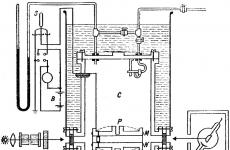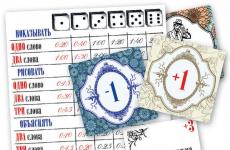The words for playing the hat are interesting. Salon game "hat. Preparing to play
"Hat" is an artistic game for a pleasant company. In it, you have to pull all sorts of words and concepts out of your hat, and then show, explain and draw them. Each participant in turn becomes the leader, and the rest of the players guess what exactly he is trying to convey to them. If the word is named correctly, both the one who guessed it and the leader get victory points. To earn more points, the facilitator can voluntarily shorten the time allotted to him or complicate his task: for example, draw only rectangles or show by clenching his fingers into fists.
Preparing to play
Before the start of the game, players will need to acquire a Hat and a timer. The hat of the same name will serve as an ideal Hat, but it can be successfully replaced by any container from which you can blindly pull out leaves with words, for example, an opaque bag or a deep box. The timer should measure time with an accuracy of five seconds: it is most convenient to use the built-in smartphone or tablet, but a sports stopwatch is also suitable. Now we need to fill the Hat with words. To do this, you can cut one or more ready-made sets into it (four of these sets are included in the box with the game), or you can write the words yourself on pieces of paper - but then it will not be so interesting to guess them. After mixing the words in the Hat, the participants choose the first leader and start the game.
How to play
On his turn, the leader first of all opens a card from the "Hat" deck. It indicates how many words he will pull out of the hat and how he will convey them to other players, for example: "Explain three words", "Draw one word" or "Show two words." Each task has its own standard in minutes and seconds: for the given examples, it is forty seconds, one minute and three and a half minutes, respectively.
Then the presenter can, if he wants, choose a complication: reduce the time allotted for guessing or draw out an additional condition card. If desired, he has the right to do both - if he is absolutely confident in his own strength or needs additional victory points. To shorten the time, the presenter rolls a die and checks with a special table: the fewer drops, the faster he has to cope with his task. An additional condition card is drawn from the deck corresponding to the way of completing the task: "Explain", "Show" or "Draw". This condition - for example, do not use verbs during the explanation or draw with the left hand - will apply to all words of the assignment.
Finally, the players start the timer, the presenter draws the required number of words from the Hat and explains, shows or draws them in turn. Explaining, the player must only speak, while it is forbidden to name the hidden word, related words or parts of it - including in foreign languages. When drawing, you cannot write anything, as well as help yourself with words and gestures. It is allowed to show words with any movements, but you should not "write" letters and numbers in the air, or make any sounds. As soon as the word is guessed, the presenter moves on to the next one. This continues until the leader completes his task to the end or the timer rings.
Victory points are awarded at the end of the turn. If the leader was able to explain, show or draw at least one word, he keeps a task card for himself - it brings two points. However, if the player did not manage to deal with all the prescribed words, he receives one penalty point. A similar penalty is imposed for breaking the rules. Victory points for complications are awarded only if all the necessary words are successfully guessed: 1 or 2 points are given for reducing the time, and the value of additional conditions is indicated on their cards. For each guessed word, the player gets a point, and if several people say the word at the same time, points are awarded to each of them.

The game continues until all the cards with tasks from the Hat deck have been played or until the words run out. The player with the most points is declared the winner.
Of course, these games are great and will suit any company. But sometimes, especially when the same people often gather and play, even the most beloved games get a little boring and I really want something new. For us, the game has become such a game Hat! Yes, it combines elements of games that are already familiar to us all, BUT, nevertheless, this is exactly the very new thing that we lacked.
Here's how the manufacturer describes the game. “The hat is a game for a big good company that everyone plays together. Each of the players in turn tries to explain, show or draw a word, and everyone else tries to guess this word. Those who succeed, as well as the player who explained the word, receive victory points. It happens that you need to explain a few words at once, and time is always limited. Moreover, the player can shorten the time allotted to him or complicate his task in some other way, and then he will receive more points. The players get new words from the Hat. The number of options is huge. The participants of the game themselves choose how to fill the Hat - changing the complexity of words, subject matter, language. Each time there may be new words in the Hat, unknown to the players, and if you wish, you can even come up with words for playing the "Hat" yourself. "
Now let's talk a little more about the composition and course of the game.
The game includes:
Hat cards - 24 pcs
Cards with additional conditions
- "Explain" - 8 pieces
- "Draw" - 8 pieces
- "Show" - 8 pieces
Cards + 1 / + 5 - 24 pcs
Cards -1 / -3 - 8 pcs
Sets with words - 4 pcs
Time table
Dice
Preparing for the game:
Before starting the game You need to lay out the cards "hat", "explain", "show" and "draw" in three piles. The cards "+ 1 / + 5" and "-1 / -3" are also placed in the center of the table. You will also need a stopwatch, a sheet of blank paper and a pen, as well as a hat or something replacing it, where cards with words are folded.

Game progress:
The player who starts reveals the top card from the hat pile. On cards of this type, the way the words are explained, their number, as well as the time it takes to draw / explain or show these words. The number of points that the player will receive if his words are guessed is written in the upper right corner. The player who guessed the words correctly takes a card from the "+ 1 / + 5" pile - one victory point.
Explain- in this case, the player cannot name words of the same root, and also cannot show and draw this word. You can name synonyms or antonyms or tell what this word means.
Drawing, the player cannot tell or show anything. You cannot write letters and numbers. You can point your hand at the participant who has begun to guess the word correctly, thereby showing that he is moving in the right direction.
Showing word, you can't say anything.
For example, a player pulls out a hat card

This means that you need to explain in words 2 words (pulled out of the hat) in 35 seconds. If the player succeeds, they score 2 victory points. (the one who guesses the word gets 1 point for each guessed word). After that, the player takes out 2 cards with words from the hat and explains them in turn.
It seems that everything is extremely simple? Yes, it is, but the rules allow you to complicate the task and thereby earn more points! A player who wants to complicate the task for himself, after taking the "Hat" card and already knows in what way he will have to clarify the words, can do the following:
Reduce the time for clarification (this just requires a dice and a temporary table)

You can draw a card of additional conditions (the top card is taken from the corresponding pile. If, for example, on the card "Hat" it is indicated that the words must be shown, then the card of additional conditions must be drawn from the pile of "show".
Additional conditions can be very different - to show the words while sitting or constantly smiling, to show, clenching your fingers into fists, or even to show the word while blindfolded.
Explaining words with the help of a picture, additional conditions can be to draw only squares and rectangles, draw only ovals or circles, draw with the left hand.
And with a simple explanation of words, the conditions can be, for example, to sing the words or after each spoken word, say "Hat", etc.
You can use one of the complications, or you can use both at once.
For example, if to the Hat card, you decide to shorten the time and roll a dice and the number 3 falls on the dice, then in accordance with the time table, you need to explain 2 words in 20 seconds (instead of 45 seconds that were originally on the card)
Victory points are calculated at the end of each round.
Playing "Hat" is fun and small company (for example, four), but much more fun and interesting if you try to play in teams! And the good thing about the game is that you don't have to play by the proposed rules. You can complicate and confuse the game, or, conversely, simplify and adapt the rules for younger players!
On my own behalf, I can add that at the moment it is a favorite game in our adult company, as well as in the company of children of different ages (those who cannot yet read are helped by a “partner”)! For small children, you can make your own cards with words (by the way, additional sheets of paper with empty cells for this are included in the game)
Various and fun games for you!
"Hat" is a game for a big good company, which everyone plays together. Each of the players in turn tries to explain, show or draw a word, and everyone else tries to guess this word. Those who succeed, as well as the player who explained the word, receive victory points. It happens that you need to explain a few words at once, and time is always limited. Moreover, the player can shorten the time allotted to him or complicate his task in some other way, and then he will receive more points. The players get new words from the Hat. The number of options is huge. The participants of the game themselves choose how to fill the Hat by changing the complexity of words, subject matter, language. Each time there may be new words in the Hat, unknown to the players, and if you wish, you can even come up with words for playing the "Hat" yourself.
Preparing to play
Disassemble the "Hat", "Explain", "Draw" and "Show" cards into separate decks. Shuffle each deck separately and place them face down on the table. Place the cards "+ 1 / + 5" with the inscription "+1" up in the center of the table so that it would be convenient for all players to take them. Place cards "-1 / -3" nearby. Prepare a watch with a second hand or a stopwatch, as well as clean paper and a pen. You can use a mobile phone or PDA as a stopwatch. You will need some other container from where the players will get the sheets with the words, better anybody's Hat will do just fine for this purpose. But it can be any headdress or, for example, a bag, a package. Place the words you will be using in the Hat. Players should not look at which words go into the Hat.The game
The owner of the Hat starts the game. If there is no such thing or there are several of them, then the right of the first move is determined by lot. This player reveals the top card from the Hat deck. The card shows the way and the number of words played. Depending on the specified method, the player must explain, draw or show these words. The rest of the participants in the game must guess these words. Explaining, the player cannot name the word he is explaining, the same root words (by the word or its parts), this is a word translated into another language. Also, it is not necessary to write, draw, show with gestures. While drawing, the player cannot speak or show anything. Letters and numbers (including roman) cannot be written. It is allowed to point with your hand at the participant in the game, expressing the correct versions of the predicted word, and nodding. While showing, you cannot speak, but you can only depict the words in pantomime. It is also impossible to write letters and numbers in the air, but you can show the score on your fingers. Each card "Hat" indicates the time for which it is necessary to play (explain, show or draw) the corresponding number of words. The player to the right of the player to the right of the player is always timed. The player can make it more difficult for himself to play the words and get more points for it:The man stretched out his arms to the sides and waves them. Is it a bird? This is a plane? Maybe a windmill? No, it's not that. Sometimes people are so dull that you want to shout at the top of your lungs: "Yes, this is a washing machine!" But the rules require you to remain silent, the timer inexorably counts down the time, and when friends finally recognize the ill-fated unit, it will still be necessary to show them inspiration.
"Hat" is an artistic game for a pleasant company. In it, you have to pull all sorts of words and concepts out of your hat, and then show, explain and draw them. Each participant in turn becomes the leader, and the rest of the players guess what exactly he is trying to convey to them. If the word is named correctly, both the one who guessed it and the leader get victory points. To earn more points, the facilitator can voluntarily shorten the time allotted to him or complicate his task: for example, draw only rectangles or show by clenching his fingers into fists.
Before the start of the game, players will need to acquire a Hat and a timer. The hat of the same name will serve as an ideal Hat, but it can be successfully replaced by any container from which you can blindly pull out leaves with words, for example, an opaque bag or a deep box. The timer should measure time with an accuracy of five seconds: it is most convenient to use the built-in smartphone or tablet, but a sports stopwatch is also suitable. Now we need to fill the Hat with words. To do this, you can cut one or more ready-made sets into it (four of these sets are included in the box with the game), or you can write the words yourself on pieces of paper - but then it will not be so interesting to guess them. After mixing the words in the Hat, the participants choose the first leader and start the game.
On his turn, the leader first of all opens a card from the "Hat" deck. It indicates how many words he will pull out of the hat and how he will convey them to other players, for example: "Explain three words", "Draw one word" or "Show two words." Each task has its own standard in minutes and seconds: for the given examples, it is forty seconds, one minute and three and a half minutes, respectively.
Then the presenter can, if he wants, choose a complication: reduce the time allotted for guessing or draw out an additional condition card. If desired, he has the right to do both - if he is absolutely confident in his own strength or needs additional victory points. To shorten the time, the presenter rolls a die and checks with a special table: the fewer drops, the faster he has to cope with his task. An additional condition card is drawn from the deck corresponding to the way of completing the task: "Explain", "Show" or "Draw". This condition - for example, do not use verbs during the explanation or draw with the left hand - will apply to all words of the assignment.
Finally, the players start the timer, the presenter draws the required number of words from the Hat and explains, shows or draws them in turn. Explaining, the player must only speak, while it is forbidden to name the hidden word, related words or parts of it - including in foreign languages. When drawing, you cannot write anything, as well as help yourself with words and gestures. It is allowed to show words with any movements, but you should not "write" letters and numbers in the air, or make any sounds. As soon as the word is guessed, the presenter moves on to the next one. This continues until the leader completes his task to the end or the timer rings.
Victory points are awarded at the end of the turn. If the leader was able to explain, show or draw at least one word, he keeps a task card for himself - it brings two points. However, if the player did not manage to deal with all the prescribed words, he receives one penalty point. A similar penalty is imposed for breaking the rules. Victory points for complications are awarded only if all the necessary words are successfully guessed: 1 or 2 points are given for reducing the time, and the value of additional conditions is indicated on their cards. For each guessed word, the player gets a point, and if several people say the word at the same time, points are awarded to each of them.
The game continues until all the cards with tasks from the Hat deck have been played or until the words run out. The player with the most points is declared the winner.
Ready-made sets of additional words for the "Hat" can be purchased separately. They are folded in such a way that no one, including the owner, could read the words ahead of time. Before the game, it is enough to cut a strip of paper into the Hat along the dotted lines and mix the resulting pieces of paper. The simplest words are printed on white paper, complex ones (such as abstract concepts or scientific terms) - on green, and combinations of two or more words - on red. Coming up with your own sets of words, "Hat" can be used not only for entertainment, but also for learning - for example, foreign languages.
Forum on the game "Hat" on the BG site G
If you have any questions about the rules of our game, we will be happy to answer on a special forum about it on the international portal BoardGameGeek in Russian.
Multi-faceted entertainment
At the heart of the "Hat" is folk fun, known in Russia under a variety of names: "Associations", "Pantomime", "Crocodile" and even "Slouching dog". This game has no less options than names: you can make words in your ear or pull out from pre-written ones, play in pairs, teams, or every man for himself, limit yourself to pantomime or explanations ... "Hat" not only offers players uniform rules and eliminates the need to invent words, but also brings to the game the exquisite atmosphere of a high-society salon for noble ladies and gentlemen. Perhaps it was in this environment that the history of this ever-popular game began.
- Purpose of the game- in a limited time, explain to your partner as many words pulled out of the hat as possible.
- General course of the game
Players sit around the table (usually 6-10 people). The hat contains a number of words written on pieces of paper; players do not know these words. At each moment of time, two people play - an explainer and a guessing one, the rest of the players wait their turn and listen. The explaining player, at the command of the referee, takes a piece of paper out of the hat, reads the word written on it (to himself) and explains this word to the guessing player, not using words of the same root to the guessed one, as well as profanity. The guessing player offers versions until he names the hidden word. After that, the explainer puts the piece of paper with him aside, takes out the next piece of paper and explains the next word. Guessed words will not be returned to the hat. When the time expires, the referee stops the game. If the word is not guessed, then the explainer returns the piece of paper to the hat, without informing the players and spectators of the hidden word. The hat then moves to the next player clockwise.
The explaining player, at the command of the referee, takes a piece of paper out of the hat, reads the word written on it (to himself) and explains this word to the guessing player, not using words of the same root to the guessed one, as well as profanity. The guessing player offers versions until he names the hidden word. After that, the explainer puts the piece of paper with him aside, takes out the next piece of paper and explains the next word. Guessed words will not be returned to the hat. When the time expires, the referee stops the game. If the word is not guessed, then the explainer returns the piece of paper to the hat, without informing the players and spectators of the hidden word. The hat then moves to the next player clockwise. - Varieties of the game
The game can take place in two formats: doubles and personal.- Doubles. In doubles play, as is most often played in companies, all players are divided into pairs (therefore, the number of players must be even). The players of each pair sit opposite each other so that there is no confusion with the change of players. Each player explains words only to his partner. Each pair gets as many points as the number of words she guessed. You can play either a predetermined number of "circles" of the hat around the table (for example, each one explains the words seven times), or until the words run out (but then the pairs are not on an equal footing - someone will guess more times).
- Personal game. In the individual game, each player explains words to different players. For each guessed and for each guessed word, the player receives a point. Usually, in a personal game, the scoring is done by the referee. When playing in the field, you can tear each piece of paper with a guessed word in half and give its half to the one who guessed the word (the second one is kept by the one who explained it). Then the number of pieces of paper collected by the player is the number of his points.
The optimal scheme for personal play is when everyone makes a choice of words to each one once. Each circle, all players make words to the one who sits at the table in relation to them in a certain position. For example, in the first circle everyone thinks of words to the neighbor on the left, in the second circle - to the player through one to the left, etc. Or you can also play like this: in the first circle, everyone thinks to the person sitting opposite, in the second - to the one who sits to the right of the one who is opposite, in the third - to the one who is to the left of the one sitting opposite, etc. If there are too many players or too few words, you can play and not a complete set of circles.
- Particulars
- The words to be made are common nouns in the singular (if there is one; "scissors", etc., you can guess). The word is considered guessed if the guesser pronounced it in any form (for example, "Soap Mom ..." - "Ramu" if "Rama" is enumerated). The word is considered guessed if the guesser uttered a word that sounds the same as that written on a piece of paper, the so-called homophone (for example, "Such with a quiver" - "Bow", if "Meadow" is envisioned). You can also combine these rules (for example, "I enter into ..." - "Marriage" if "Braga" is envisioned) .
- single-root * the hidden word. Words that have the same prefix or suffix as the hidden word can be pronounced without informing that the hidden word has the same prefix or suffix. The explainer is prohibited from pronouncing abbreviations, one of the letters of which denotes a hidden word (for example, you cannot say "Moscow State University" for "University").
- It is forbidden for the explainer to pronounce the words, consonant the hidden word (as well as words that have common morphemes with the hidden word), communicating explicitly or hinting (for example, highlighting intonation) that the words are consonant (or have common morphemes, for example, "big"). It is forbidden for the explainer to pronounce the words, non-existent in Russian, if such words, together with the hidden and, possibly, additional letters form an existing word. For example, you cannot say "ptero ..." (for "dactyl") - since together they form "pterodactyl", and also "bomb ..." (for "shelter") - since together they form a "bomb shelter".


- Explaining can not appeal in no way to letters and syllables hidden word ("the first letter is the same as that of ...", "remove the last four letters", "a word of three syllables", etc.). In particular, you cannot make up words by directly naming them. anagrams(for example, “anagram from the word growth” is not allowed, but “anagram to the word denoting height” is possible). It is also forbidden to appeal to the outline of the letter("Round prefix", "in the middle like a cross"). However, it is allowed to appeal to parts of a word, without specifying their size ("change the beginning of the word", "the middle is like a word that ..."), as well as to morphemes("Change the ending", "take the prefix like my last name")
- It is also forbidden to convey any information when explaining facial expressions or gestures.


- When explaining the word, you cannot use translations in the event that one of the words (spoken by the explainer or its translation) is not in Russian with the same meaning. This includes cases without explicit appeal to translation into a given language. For example: you cannot say “hand in Russian”, “sun in English” (a hand and a dignity are conceived), “it is long” (a chaise longue is conceived).
However, if a foreign word has passed into Russian by borrowing, you can call it: "refrigerator in a simple way", "installation in English". If a foreign word is conceived, it is allowed to say from which language it is borrowed, and to pronounce the translation: "loving in Greek." Also, this rule applies to explainable prefixes and roots of foreign origin. - If the player uses certain signals to violate the rules (sequence of intonations, word distortions, etc.), then the judge issues a warning for the first time, and then, noticing the same way of appealing to the violation of the rules, removes the word. Examples: the player says the word twice to hint to the partner that the word needs to be translated; the player loudly shouts out a word to hint to the partner that he needs to take what is in tune with him, etc.
- If the word is guessed not through the meaning, but by consonance or in parts, then the B-F restrictions also apply to the explanation of any of the auxiliary words.
- If the explainer names a word with the same root or otherwise violates the rules of B-G, he returns the word to the hat (either by himself or on the recommendation of the judge) and passes the hat to the next player, thereby completing his turn. If the fact of violation is recorded after the end of the turn, then the words made with the violation or after it are not counted.
- If the guesser names a word with the same root, the word is not yet considered guessed. In this case, the explainer can report that the same root word is hidden and ask to clarify the word.
- The explainer, desperate to explain the drawn out word, can put it back in his hat and finish the explanation ahead of schedule. It is not allowed to replace a word with another.
- The time allotted for guessing words by each pair of players - 20 seconds... After the judge says “time,” the explainer stops explaining, and the guesser has more 3 seconds and one word to give the answer, after which the judge says "everything" and the answers are no longer accepted. If the guessing person could not stop after the "time" signal, the guessing person is not given the right of three seconds.

- Players who are not guessing or guessing the word at the moment should neither interfere nor help the playing pair. It is not allowed to discuss in any way words that have not yet been guessed.
- Controversial situations, as well as situations not described in the rules, are resolved by the referee conducting the game.
* In cases of doubt about the same root of words, the presenter can use






